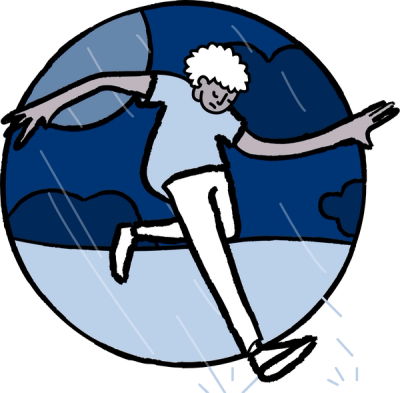You’ve probably heard it a hundred times: getting active is good for your mental health.
But that advice can feel confusing.
One person might tell you to push through a tough workout, while another says to be gentle with yourself. On some days, a run might feel like the perfect answer. On others, the thought of walking up your building's stairs might seem like too much.
What’s more, we all have differing levels of ability and mobility.
Instead, think of physical activity, movement or exercise as a set of tools. Those tools range from intense forms of exercise like swimming or football, to more mindful forms of movement like nature walks or yoga.
The point is, there’s no right or wrong way to get active.
Four ways movement can help
When people talk about exercise and wellbeing, the focus is often on endorphins and fitness. But the range of benefits you could get are much wider. That’s why you should think about what you’d like to get out of your physical activity.
1. To quiet your thoughts
When your mind is racing or you’re stuck in a loop, getting active can help you feel calm. It pulls your focus from your thoughts and into what you're seeing, hearing, and feeling.
Getting active, especially outdoors, helps to break down those thoughts in helpful ways. Or, feeling the sun on your skin or noticing the trees on your street can take you beyond those thoughts, grounding you in the present moment.
2. To feel some momentum
It's tough to feel flat, stuck, or unmotivated. Accomplishing a physical task – no matter how minor – could help build a sense of satisfaction and momentum. It might help you feel more capable of achieving a goal or give you a sense of the things you can control in your life.
3. To connect with others
Loneliness can feel heavy and isolating. Shared activities, like playing a team sport, create a low-pressure way to be around others. Focus on an activity can make building friendships feel more natural.
4. To shift your mood and energy
You might have heard this before – moving your body can release natural mood-boosters in your brain. Surprisingly, using a little extra energy can create more, helping to shake off feelings of sluggishness or sadness.
Practical first steps
Here are some small, actionable ideas. If you’re not sure where to start, find a statement below that matches how you’re feeling today, and try out one of the suggestions we’ve listed underneath.
If you’re thinking, 'My mind is busy and I can’t switch off…'
The goal here is gentle, repetitive movement. If a busy mind is a regular source of stress for you, it might be useful to learn some tools for long-term help for stress.
- Go for a slow walk without headphones. Pay attention to the sights and sounds around you, the feeling of your breath and the rhythm of your footsteps.
- Find a simple stretching video online and follow along.
- Go birdwatching. You can read a guide on birdwatching for beginners here.
If you’re thinking, 'I feel a bit flat, like I’m in a rut…'
The goal is to set and meet a small, tangible challenge. If you're feeling low, it can be hard to get started, but there are many practical things you can do to feel better right now.
- Try something new. Look for a beginners yoga, salsa dancing, or tai chi class.
- Head down to your local river, beach or swimming spot – even if you don't get in, it's a nice chance to get out of the house.
If you've tried some of the things above and are looking for more of a challenge, you might want to build on your momentum. In that case, you could:
- Train for a community fun run. These kinds of events focus on participation, not just speed.
- Commit to a full season of a social sport or a longer-term community class.
- Explore a longer trail in a nearby national park. For tips, check out this article on how to go on longer bushwalks safely.
If you’re thinking, 'I’m feeling lonely and disconnected from people…'
The goal is to find a shared, low-pressure activity. You can find more suggestions in our article on practical things you can do in the moment if you're feeling lonely.
- Look for a local social sports league like Urban Rec where the focus is on fun, not winning.
- Find a local walking group or a community class at a neighbourhood centre.
For more ideas that don't involve getting active, read our guide on building social connections.
If you’re thinking, 'I just feel low and drained of all energy'…
Here, the goal is to get your heart rate up, even if it’s just for a few minutes.
- Put on your favourite high-energy song and dance around the living room.
- Find a short, beginner-friendly workout video online.
If these feelings of low mood are common for you, you may find it helpful to learn about some short-term strategies for managing feelings of depression.
Are feelings of low mood are common for you? Learn about some short-term strategies for managing feelings of depression.
Exercise and healthy boundaries
While movement supports our wellbeing, it's also important to set healthy boundaries and notice when it might be tipping into an unhelpful pattern.
Signs that exercise could be becoming unhealthy include:
- Feeling guilt or shame about resting your body.
- An inability to take a break, even when you know you need one.
- When your overall physical or mental health starts to suffer because of your activity.
- Exercising when you're already in an energy deficit or not adequately nourished.
To learn more about navigating this balance, read Sarah's Story.
In summary: the best way to get active
The best way to get active is whichever way meets you where you are today. Listening to what you need is the real skill, and it’s one you can build over time.
Be kind to yourself. Some days will be easier than others! Any movement, no matter how small, is a step in a positive direction.






